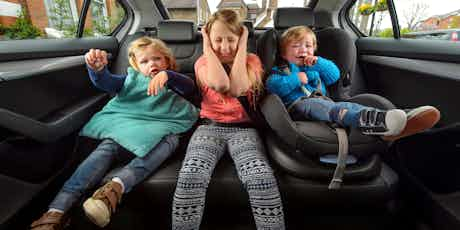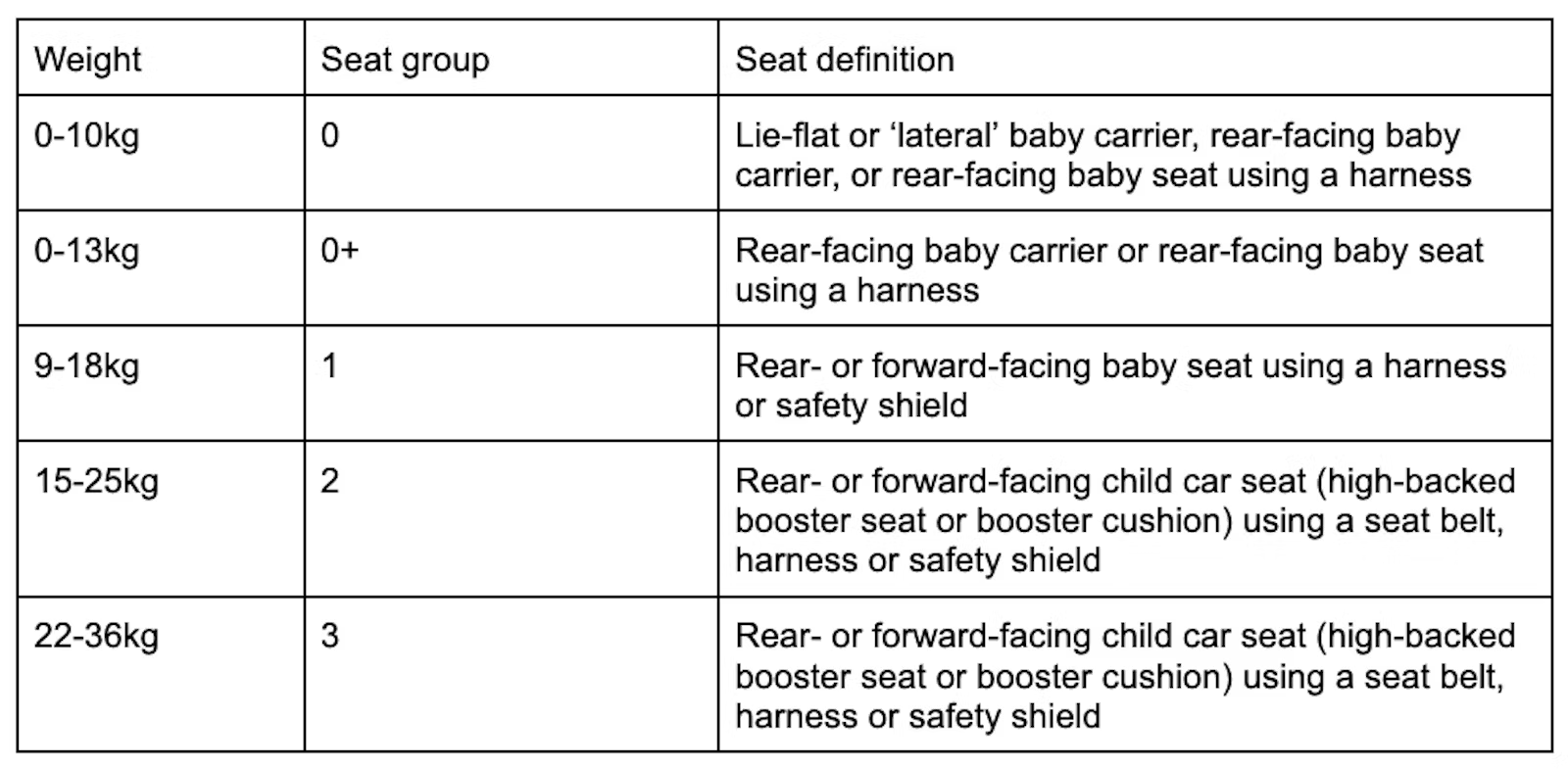What’s the law for children’s car seats?
October 20, 2022 by carwow staff

Getting the correct child seat is important both from a safety and legal perspective; we explain the rules
It was only in 1991 that it became a legal requirement for rear-seat passengers to wear a seatbelt. Given the back seats are the traditional home for children in cars, that’s pretty staggering to think about.
Attitudes are very different today, though, and the rules governing how children must be secured in cars are far more strict – but they’re also pretty complex.
This is partly because you can follow rules based on a child’s height (these are known as i-Size rules) , and rules based on their weight, while their age also plays a part in their seating requirements.
The key thing to know is that children must be in some form of child seat until they are 12 years old or 135cm (4’5″) tall; they can switch to using a standard seatbelt with no child/booster seat once they cross either of those milestones.
Car seat rules for babies
i-Size rules dictate that babies must be in a rear-facing child seat until they are 15 months old. After that point they can move to a forward-facing seat.
Weight-based rules mandate that babies must be in rear-facing seats until they are at least 9kg.
You can abide by either of these rules and be on the right side of the law.
Many babies get bored and fractious in rear-facing seats, as their view out is only of the backrest of the rear seats and they cannot see their parents in the front; but while this can make long journeys somewhat trying, it is safest to keep babies in rear-facing seats for as long as possible, as they give better protection than forward-facing seats.

In fact, it is recommended to keep children in rear-facing seats until they are four years old and 105cm tall, as their neck and head are particularly vulnerable in collisions up to this point.
Car seat rules for children
The following table, taken from the Government’s guide to the topic, outlines the different ‘groups’ of child seat available under the weight-based system.

There is no equivalent table for the i-Size regulations, as different child seats will be designed for different-height children, with this information displayed clearly on their marketing material.
What do i-Size rules say?
i-Size, as well as being height rather than weight-based, requires child seats to have Isofix mounting points. These are metal or plastic arms on the seat that mechanically latch onto dedicated mounting points in the car. All cars made from 2012 with four or more seats must have Isofix mounting points, though many cars built before this date have them. i-Size seats will often allow the car’s seatbelts to be used to secure the child seatsin case the vehicle does not have Isofix points.

i-Size regulations also mandate improved side and front-impact protection, as well as the requirement for children to be in rear-facing child seats until they reach 15 months.
When can children travel in the front seat of a car?
The rear seats are the safest place to transport children, but if there is no space for them back there they can travel in the front seat as long as they are in the correct child seat for their weight/age/height.
If the child seat is rear facing and the child is travelling in the front, the front passenger airbag must be deactivated, else it poses a risk to the child in the event of a collision. Consult your vehicle handbook to find out how to deactivate the passenger airbag.
If there is no space in the rear of the car for a third child seat, a child under the age of three must travel in the front seat of the car in the correct child seat. Children aged three or older can legally travel in the rear of the car wearing an adult seatbelt if the journey is unexpected, necessary and over a short distance (all three criteria must be met).
How do I fit a child car seat correctly?
In all instances we recommend that you consult your vehicle’s handbook and the instructions that come with the child seat to ensure correct fitment.
If the child seat and your car has Isofix points, this should be a fairly straightforward procedure. Locate the two mounting points in the base of the rear seats, removing any cover that might be in place. Lock the Isofix points of the child seat into the Isofix mounting points; you should feel or hear a noticeable ‘click’ when doing so, confirming the points are engaged.
Some cars have ‘top tether’ mounting points on the back of the rear-seat backrest; these will typically be accessed from the car boot, and see a strap extend from the seat and latch on to this tether.
If fitting a child seat with a car’s seatbelt, follow the instructions provided with the seat. Never fit a child seat sideways – it must always be facing forwards or backwards.
Do I need to use a child car seat in a taxi, minivan, or bus?
There will inevitably come times in a child’s life when impromptu trips in vehicles are required, and in these instances legislation can allow for them to not be in child seats.
Taxis
If the taxi driver does not have a child seat, children over three can travel in the rear seats wearing an adult seatbelt. Children under three can travel without a seatbelt in the rear seats of a taxi only if the journey is unexpected.
Coaches
Children can travel without a child seat or seatbelt if these are not available.
Minibuses
Children over three must use a child seat or seatbelt if there is one available; they should use the adult seatbelt if they are not. Children should be in the rear seats if there are no seatbelts or child seats in the front of the minibus.
Vans
Rules for vans are the same as rules for cars.
Dos and don’ts of children’s car seats
Do
- Ensure the child has the correct seat for their age.
- Ensure the child seat is mounted correctly and the child is securely strapped in to the child seat.
- Place them in the rear seats if at all possible.
- Ensure the front passenger airbag is deactivated if placing a rear-facing child seat in the front of the car.
Don’t
- Transport a child without a child seat.
- Mount child seats sideways in the car – they must be forward or rear facing.
What to look for when buying a child car seat
First, it is a bad idea to buy a second-hand child seat; there is no way of knowing if it has been involved in a collision, while the instructions may be missing or incorrect and the seat may be less effective due to wear and tear.
Many child and baby seats, particularly ones with Isofix, can be used with a separate base. The base is fitted to the car, with the child seat clipping onto the base with an unmistakable ‘click’, and often an indicator showing it is correctly installed.
These bases can be very useful with younger children, who may fall asleep on car journeys, and can be taken out of the car by removing the seat from the base, rather than having to remove the child from the seat, potentially waking them.
Some child seats also come as systems that ‘grow’ with the child, meaning that by removing or adding components, the seat can be adapted for the child’s increasing age and size. A typical system might, for example, be mounted as a rear-facing seat, but also be able to be mounted forward-facing when the child grows, before becoming a high-back booster seat for later on in their life. Other systems may see
Some child seats can also click straight from the car into a pram or pushchair frame, sometimes with adaptors for the mounting points.
Bases may also allow the seat to swivel so it is facing the car door when the child is placed and strapped into the seat, before swivelling into the correct rear or forward-facing orientation for transportation. This can make life a lot easier as it it saves you twisting your back as you strap the child in.
Change cars online with carwow
Looking for an easy way to change your car? Then carwow is the place to go. You can sell your car online for a great price, and get the best deals on a new one. All through our network of trusted dealers and all from the comfort of your home. Tap the button below to get started today.















